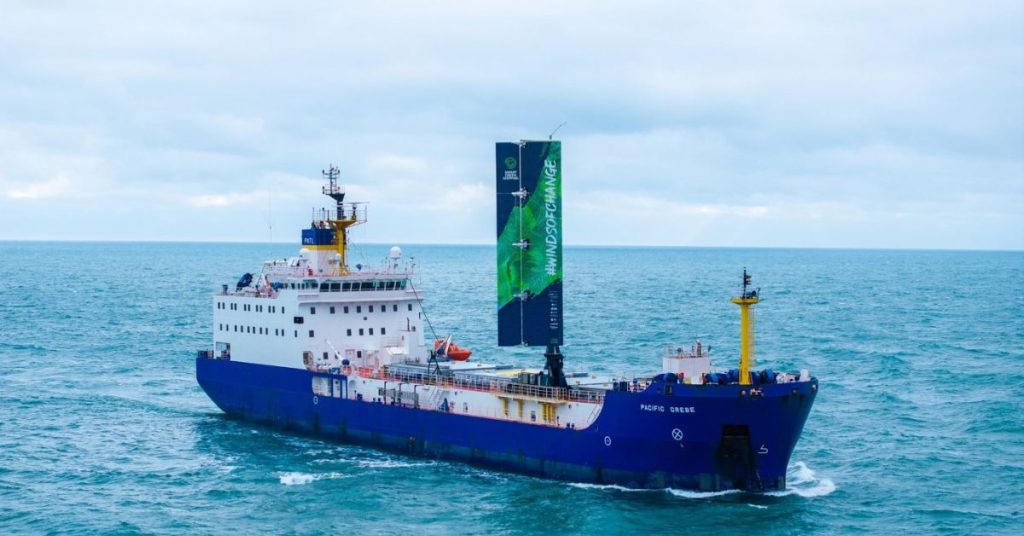Smart Green Shipping (SGS) has announced the successful completion of sea trials for its FastRig wind-assisted propulsion system, conducted in late 2024 aboard the MV Pacific Grebe, a vessel typically used for transporting nuclear waste.
The trials mark a significant step forward for wind-assisted propulsion in commercial shipping, demonstrating both the practical installation and operational efficiency of the FastRig system. The trials included a full installation carried out dockside, extensive sea testing, and subsequent removal — all completed within an eight-week period and in compliance with both the vessel owner’s and the Class Society’s requirements.
Despite the unique challenges posed by retrofitting such a specialised vessel, the FastRig’s modular and lightweight design enabled a rapid, streamlined installation process. SGS emphasized the system’s minimal impact on vessel structure and operations, particularly with regard to visibility, onboard energy consumption, and installation time — all of which are key concerns in the commercial shipping sector.
Diane Gilpin, CEO of Smart Green Shipping, highlighted the practical advantages of the FastRig, noting that its lightweight and stowable configuration significantly reduces the need for structural reinforcement and avoids reliance on powered systems such as fans or rotors. “Our sea trials provide clear, verifiable evidence that FastRig can be installed and removed efficiently — even quayside or during scheduled drydock periods — without compromising operational safety or adding administrative burden to crew,” she said.
In an industry first, SGS chartered its own vessel to conduct the tests, ensuring compliance with International Towing Tank Conference (ITTC) protocols. This gave the company unrestricted access to operational data and allowed for a complete performance evaluation of the vessel, rather than isolating the wind-assist system.
Independent verification of the trials was carried out by the University of Southampton and clean technology consultancy Houlder. Their assessment confirmed that SGS’s performance modelling tool, FastRoute, reliably predicts fuel savings, with FastRig shown to reduce fuel consumption by up to 40% annually. When paired with FastRoute’s route optimisation capabilities, this figure can increase by a factor of 1.5.
The FastRig system is designed for ease of use and minimal disruption. It occupies a small footprint on deck, supports automated operations to reduce crew workload, and includes a dedicated radar system to maintain visibility and safety during operations in port and at sea. The use of commercially available components in innovative configurations also helps to reduce maintenance time and costs.
SGS’s innovation is backed by several sponsors, including Drax Group, one of the world’s largest producers and users of biomass for renewable energy. Mark Gibbens, Head of Logistics at Drax, commented on the broader implications of the technology: “Wind energy is a freely available and renewable resource. Scalable, cost-effective solutions like FastRig are vital in helping the maritime sector move toward Net Zero goals and support cargo owners in reducing Scope 3 emissions across their supply chains.”
Tags: CLean Shipping, Decarbonisation, FastRig, Green Shipping, Green Technology, Logistics, Maritime Innovation, Sustainable, Wind Propulsion



Recent Posts
Royal Caribbean Welcomes LNG-Fueled Star of the Seas to Its Fleet
Swire Shipping Launches ‘Voyage to Zero’ to Help Customers Cut Scope 3 Emissions Swire
Pinnacle Marine Launches B100-Powered President 100 for Biofuel Trials
Assam Puts Green Hydrogen Policy on Hold, Investors Reassess Plans
MNRE and Odisha Chart Roadmap for National Green Hydrogen Mission
Hyundai Glovis to Retrofit Seven PCTCs with Avikus AI Navigation System
Super Terminais orders three more Konecranes Gottwald ESP.10 Mobile Harbor cranes
Covestro and HGK Shipping Extend Partnership to 2040 with Focus on Wind-Assisted Vessel Retrofit